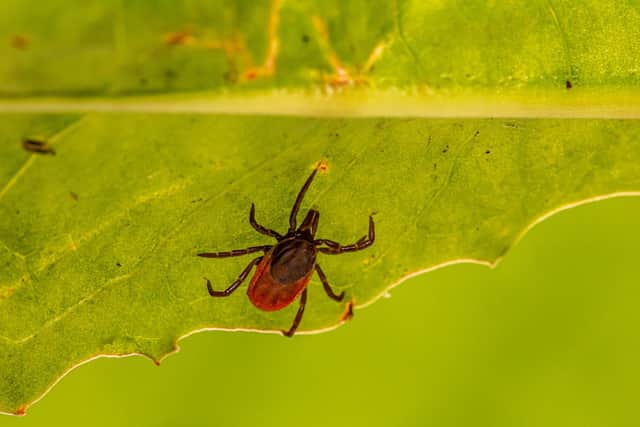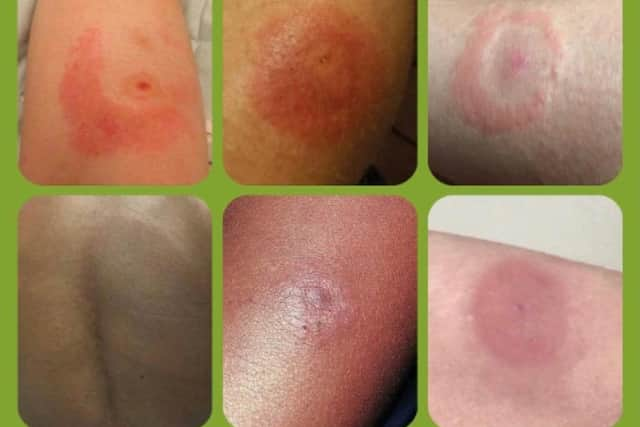Lyme disease: what is Lyme disease, how do you get it and what to do if you find a tick
and live on Freeview channel 276
It's usually easier to treat if it's diagnosed early.
According to charity Lyme Disease UK symptoms include malaise, unexplained flu-like symptoms, soreness and achiness, light and noise sensitivity, cognitive problems, fatigue, a stiff neck, facial palsy, numbness and tingling.
It also notes that not every Lyme disease patient will experience a rash, figures state that the rash appears in two out of every three. It may not appear straight away and they advise people to draw a ring around suspicious looking rashes to track any potential changes.
Advertisement
Hide AdAdvertisement
Hide AdGaye Neve, from Mid Sussex, has had Lyme disease since September 2010.
It started off with flu like symptoms - a sore throat, shivery, stiff neck which gradually got worse over a couple of weeks.
Gaye commented on Facebook: “I thought in fact I had tonsillitis. I then discovered a teaplate sized red coloured rash on the back of the upper part of my left leg. I actually thought I had an infected scratch as had been out blackberrying but no.
"The rash was circular with a spot in the middle often called the bullseye rash which I now know is called erythra migrans (EM rash). The centre spot is where I was bitten by the offending tick. My GP diagnosed Lyme disease he rang the Royal Sussex hospital in Brighton to find out what medication was required.”


Advertisement
Hide AdAdvertisement
Hide AdTwo weeks of antibiotics followed. In the UK, Lyme disease can be successfully treated with a full course of antibiotics.
If left untreated, the infection can spread anywhere in the body leading to around 70 recognised symptoms. People can develop issues with their endocrine and neurological systems and experience musculoskeletal, cardiac, dermatological and neuropsychiatric problems.
Clair-Louise Walsh, got in touch via the Bexhill-on-Sea Observer Facebook page, she was diagnosed in November 2010.
Since her diagnosis Clair-Louise admits she has been on a Lyme disease rollercoaster.


Advertisement
Hide AdAdvertisement
Hide AdShe said: “I’ve had some good years but when my Lyme is triggered, which it often is, the face paralysis flares up, the night sweats come back but by far, the most debilitating symptom for me is the exhaustion it causes. It floors me.
“My skin turns a strange shade of grey and I can barely lift my head. It's so challenging to complete even the simplest of tasks when the Lyme fatigue hits. This has been a real struggle since becoming a mum as of course having a little one requires a lot of energy and there are days when I have absolutely none. This impacts my life the most.”
Clair-Louise’s symptoms were much like Gaye’s, but she started to develop pins and needles in her right foot and tingling sensations in her hands and red rashes on her eyelids. She then developed a nasty flu and couldn’t shake the high fever and night sweats for months.
She said: “Finally I woke one morning and was paralysed on the left side of my body, my entire left arm and left side of my face were badly effected. A colleague suggested I ask to be tested for Lyme disease and a blood test concluded that Borrelia was causing my mysterious illness.”


Advertisement
Hide AdAdvertisement
Hide AdTick bite prevention and correct removal is crucial when it comes to avoiding Lyme disease.
The longer a tick is left to feed, the higher the chances are that it will pass on any diseases it’s carrying. Incorrect removal will also increase the chances of disease transmission. So whilst it is important to remove the tick as soon as possible, it is equally as important that the tick is removed correctly.
Charity Lyme Disease UK suggests: fine-tipped tweezers as they are slim enough to get close to the tick’s mouth parts without coming into contact with the body of the tick, which avoids compressing it.
Do not twist or jerk the tick as this may leave its mouth parts embedded, or cause it to regurgitate disease-causing fluids. If any mouth parts do break off, they may be removed with a sterilised needle or tweezer points.
Advertisement
Hide AdAdvertisement
Hide AdDo not squeeze or crush the body of the tick, because its fluids (saliva and gut contents) may contain disease-causing organisms and leak into the host’s bloodsteam or into the skin.
Do not handle the tick with bare hands.
You can also use tick removal tools, such as O Tom Tick Twister but if you don’t have those you can also use dental floss, a fine thread or a hair and tie a loop around the mouthparts of the tick and pull upwards and outwards. Do not twist.
For anyone who has recently diagnosed, Clair-Lousie said: “Find a good, Lyme literate doctor who will listen to you and understand your experience. Find Lyme Disease groups on social media or in your local community who can offer support and share their own experiences with you, and finally, take it one day at a time. There is a lot of great stuff happening out there in the Lyme disease research field and people are working hard on finding ways to help us, there is hope. You are not alone.”
Lyme Disease UK is a registered charity which exists to support people who are living with Lyme disease and looking for support and guidance.
Julia Knight, press and community outreach manager, said: “We work hard to provide support and raise awareness of Lyme disease amongst the UK public and healthcare systems. Throughout the year, the LDUK team attends public events, meetings and conferences, liaises with other Lyme disease organisations, and campaigns for an increase in knowledge and advancements in patient care.”
For more information visit, https://lymediseaseuk.com/